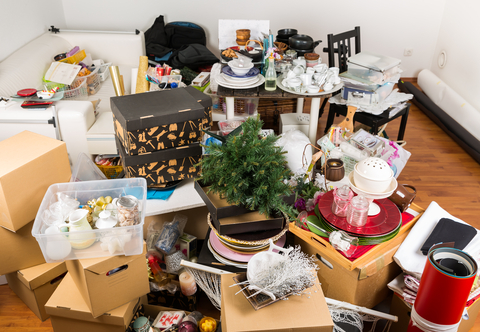Each year, January is the month I resolve to become more organized. Like many resolutions, I start strong. I put out cardboard boxes in the spare bedroom, with post-it notes marked “donate,” “keep,” or “toss” on them. I pack up random mugs and unused kitchen tools. I stuff garbage bags full of clothes we no longer wear. I have way more shoes than feet, so some of those have to go. Jackets, purses, glassware, junk drawers—the bags fill up and get hauled to the car.
But after it’s dropped off at the local thrift store, the house doesn’t look much different. There’s still more to do, but the rest of it has emotional strings attached. Sheet music from my grandparents’ Des Moines home. A giant card Mike gave me on our first Valentine’s Day together. A sweater my mom bought in Europe in 1964, according to a tag in her handwriting. An old Woolrich shirt from my grandpa, who died when I was four. Wooden snowshoes that hung over the fireplace in the old cabin.
A little over eight years ago we packed everything we owned into the largest moving truck we could rent and hauled ourselves across the country from Minnesota to Prescott. Despite all the stuff we gave away in the months leading up to our move, not everything would fit into the back of the truck and car on the big day. We filled every space we could, leaving only enough room for two large poodles and two elderly cats and friends helped us drop the rest off at local thrift shops.
I was sure after so much downsizing, we’d start our lives in Arizona in sparsely furnished rooms with a few books on a shelf and a cozy reading chair by the sunny living room window. It was a fresh start and I looked forward to having an organized home. But as we unpacked and found new places for our old stuff, the spaces began to fill up.
A few years later, my parents moved to Arizona permanently. Mike and I headed north to help pack up my childhood home and sift through boxes dating back decades. Some of the boxes were easy to sort through and toss: elementary school report cards, lumpy pottery pieces, and construction paper artwork my sister and I had made but Mom was too sentimental to throw out.
Other boxes were harder, filled with letters my folks and grandparents wrote to me when I was at summer camp as a kid. Postcards I wrote back to them, in wobbly third-grade handwriting, about cooking out over a campfire, the giant spider in our tent, and the friend I had made that week. Letters from the Tooth Fairy written in my mom’s perfect elementary school teacher handwriting. A letter from me asking the Tooth Fairy why the neighbor up the street got a dollar for his teeth while I only got a quarter.
Some of the childhood treasures made it back to Arizona. It was too hard to say goodbye to items I hadn’t seen in 40 years but now couldn’t imagine leaving behind. Do I need most of this stuff? No. If I give it away, will I even remember it’s gone? Probably not.
There’s a book I’ve started to read called “The Gentle Art of Swedish Death Cleaning” by Margareta Magnusson. While I hope we have many good years still ahead, I don’t like the thought of our nieces and nephews trying to decide what to do with the boxes of stuff that must have been so important to their dear Aunt Kelly. Magnusson writes, “A loved one wishes to inherit nice things from you. Not all things from you.”
Snowshoes, I think your days are numbered.

